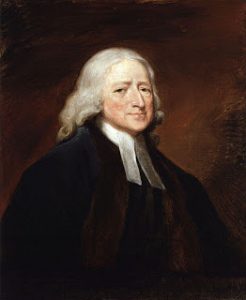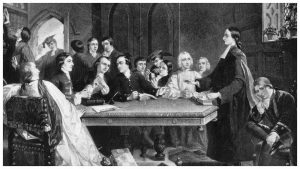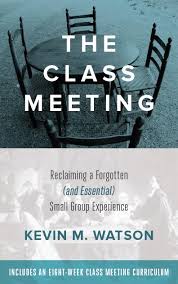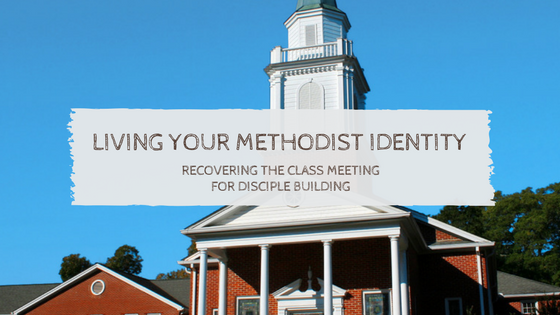And Jesus said to them. “All authority in heaven and on earth has been given to me. Go therefore and make disciples of all nations, baptizing them in the name of the Father, and the Son and of the Holy Spirit, and teaching them to obey everything that I have commanded you.” – Matthew 28: 16-18 (NSRV).
The command to “make disciples” has been the mantra of the church throughout the ages. Even today, the United Methodist Church (of which I am a part) has as its mission “to make disciples of Jesus Christ for the transformation of the world.”[1] It can be understood that the call of making disciples is the purpose of the church. In 2007-2008, the North Georgia Conference of the United Methodist Church wrote a 42-page report titled, Discipleship: Dedicated Followers of Jesus Christ. The report states: “The primary objective of the Church today as outlined by Jesus is for disciples of Jesus to develop other men and women into disciples. Discipleship should be at the forefront of our efforts. Everything we do, say and teach should be considered as we ask, “How will this help us make disciples?”[2] These words are echoed in the Mississippi Conference.
The thought of following Jesus and becoming his disciple was expressed throughout the New Testament. Throughout the Gospels, Epistles, and the Pauline letters, one reads how the apostles and the early church went about making disciples of Jesus Christ. How can the church best make disciples today? The answer is as varied as the composition of the individual churches. Some believe the best method of making disciples is teaching students within the classroom. Others believe it happens best within a worship setting where sermons are preached. Some believe that Christians who are more spiritually mature should mentor others who are less mature. These and other methods of discipleship are considered helpful, but the context of the church will depend which might be the most effective. As the pastor of Magee First United Methodist Church, the leadership and I have began to discern which model is best for our context.
What it means to be a Disciple:
 What qualifies an individual to be called a church member or a disciple of Jesus in the UMC? The Book of Discipline for the UMC states that “the membership of a local United Methodist church shall include all people who have been baptized and all people who have professed their faith.”[3] Once these actions are accomplished, it is expected that the individual will become a faithful member within the local church. “Faithful membership in the local church is essential for personal growth and for developing a deeper commitment to the will and grace of God.”[4] Also, each member is expected to participate in the life of the local church. This participation is expressed by each member being a “servant of Christ.” The Book of Discipline states, “This servanthood is performed in family life, daily work, recreation and social activities, responsible citizenship, the stewardship of property and accumulated resources, the issues of corporate life, and all attitudes toward other persons.”[5] The hope of the UMC is that each disciple will grow in scriptural holiness.
What qualifies an individual to be called a church member or a disciple of Jesus in the UMC? The Book of Discipline for the UMC states that “the membership of a local United Methodist church shall include all people who have been baptized and all people who have professed their faith.”[3] Once these actions are accomplished, it is expected that the individual will become a faithful member within the local church. “Faithful membership in the local church is essential for personal growth and for developing a deeper commitment to the will and grace of God.”[4] Also, each member is expected to participate in the life of the local church. This participation is expressed by each member being a “servant of Christ.” The Book of Discipline states, “This servanthood is performed in family life, daily work, recreation and social activities, responsible citizenship, the stewardship of property and accumulated resources, the issues of corporate life, and all attitudes toward other persons.”[5] The hope of the UMC is that each disciple will grow in scriptural holiness.
The leaders of Magee FUMC are aware that something needs to be done to increase participation in the making of disciples, and the growing of disciples.
As a member of the UMC, “Participation in disciplined groups such as covenant discipleship groups or class meetings is an expected part of personal mission involvement.”[6] Because active Sunday school classes lack participation from the majority of the membership, church leaders are discussing the formation of covenant discipleship groups which are unlike the Sunday school model.
Magee FUMC has no history of the traditional Methodist class meetings. Their small groups have been information-based driven. Congregants meet and learn the information presented by the leader. Although there is a place for this, now is the time to attempt something new. Living in an environment where little engagement with the local church occurs except on one hour each Sunday, “Our future lies in looking to our past and readapting and reasserting those principles and practices that made Methodism a great movement and denomination. To experience Mr. Wesley and the saints of early Methodism is to be directed to travel with light speed into the New Testament and the early Church and into the tradition of the historical Church, where we will find the passion and the power of the Trinity. That is where our future is waiting for us.”[7]
The leadership is ready to recommit to the local church’s mission statement: A Great Commitment to the Great Commandment and the Great Commission will build a Great Church.
History of Class Meetings:
John Wesley believed that a Christian life is more than just right thinking. For Wesley, he believed that the church should practice living a righteous life. “Yet, it is also important to be clear that for Wesley, orthodoxy, though essential to real Christianity, is not sufficient unto itself. Wesley’s deep concern was with a lived faith, not only a mental assent to propositional truth. Right doctrine, or right beliefs, was important to Wesley because it provided necessary guides and boundaries for right living. In other words, orthodoxy (right belief) leads to orthopraxy (right practice).”[8]
 Wesley wrote in “A Plain Account of the People Called Methodist” how people in London were responding positively to his message of “Jesus Christ and him crucified.”[9] Once they had accepted to follow Jesus, they realized that they needed someone to lead them in their Christian growth. They approached Wesley asking him to meet with them. He agreed to meet. The purpose of their meeting together was to “flee from the wrath to come, and to assist each other in so doing.”[10] The societies consisted of all genders, ages, and economic status, and met based on the individuals geographic location.
Wesley wrote in “A Plain Account of the People Called Methodist” how people in London were responding positively to his message of “Jesus Christ and him crucified.”[9] Once they had accepted to follow Jesus, they realized that they needed someone to lead them in their Christian growth. They approached Wesley asking him to meet with them. He agreed to meet. The purpose of their meeting together was to “flee from the wrath to come, and to assist each other in so doing.”[10] The societies consisted of all genders, ages, and economic status, and met based on the individuals geographic location.
The establishment of societies in London had been witnessed long before the Methodist United Societies. The Moravians had long influenced John. Their influence upon Wesley was both spiritual and organizational. Thus having attended a Moravian religious group, Wesley already understood both the strengths and weaknesses of religious groups. “Wesley was indebted to them in many instances for the incipient structure of his own organization.”[11] The societies quickly began to grow, and spread to other towns.
Another organizational structure was the “bands.” “The bands were voluntary cells of people who professed a clear Christian commitment and who desired to grow in love, holiness, and purity of intention.”[12] The bands consisted of smaller groups of individuals usually around five or six total. They were divided by “putting married or single men, and married or single women together.”[13] “The central function of the band methodology was what Wesley termed ‘close conversation,’ by which he meant soul-searching examination, not so much behavior and ideas, but by motives and heartfelt impressions.”[14] Compared to the class meetings, the participants’ level of maturity was greater, and their openness was expected. Those who participated in bands were not considered new believers, but those who were further along in their Christian walk. Concerning the bands, Wesley wrote “They were built up in our most holy faith. They rejoiced in the Lord more abundantly. They were strengthened in love, and more effectually provoked to abound in good work.”[15]
The third structural organization that this paper will focus on is the class meeting.
John Wesley wrote: “It scarce can be conceived what advantages have been reaped from this prudential regulation of the class-meetings. Many now happily experience that Christian fellowship of which they had not so much as an idea before.”[16]
These words of Wesley express his belief in the importance of the formation of class meetings to the growth of the Methodist Church. Dr. Albert Outler, arguably considered by many as the greatest Methodist historian, wrote: “The class-meeting was more than another experiment in ‘Christian togetherness.’ It was, in fact, a schola animarium—a ‘school for growing souls.’ It was also an agency in the permanent Christian revolution on behalf of God’s kingdom, God’s righteousness—here on earth as in heaven.”[17] With spiritual formation instilled upon the Wesley brothers, the class meeting became an obvious way to question, teach, and form spiritual growth in the people.
In the first few decades, the meetings were stern and methodical. As time passed, the meetings became less instructive, and more experiential. This moving away from accountability hindered the classes. “It is difficult to avoid the inference, that, had the classes been continuing a weekly catechesis which took seriously the accountability for works of obedience and the means of grace as well as the shaping of religious experience, their changing social context would have produced a different record from the inbred religiosity available to us in the sort of literature.”[18] As time continued, the class meetings became burdensome to its members and participation waned. Arguably, with the decline of the class meeting came the decline of the Methodist Church.
The Purpose of the Early Class Meeting:
Wesley quickly noticed the benefits of having class meetings. He recognized that the meetings could be an effective evangelism tool. With the church’s understanding of the importance of salvation, the class meeting was used as a smaller environment to spread the importance of repentance and accepting Jesus as Lord and Savior. 
From the beginning, Methodists were expected to grow in spiritual maturity. This accountability would enhance “scriptural holiness” which was expected of every Methodist. They were expected to live the fullness of a “sanctified” life. Wesley often described this sanctified life as “one moving toward perfection.” Perfection was understood as a growing in love for God, and for humanity. The class meeting helped each individual make progress toward perfection.
Wesley recognized that the meetings could be a place where each member could watch over one another in love. Wesley recognized that the class meeting “provided a sense of security, thereby meeting some basic social and personal needs of their members.”[20] The groups were better able to take care of one another.
Dr. David Lowes Watson writes: “If we seek to tradition the class meeting, however, then its significance emerges primarily with regard to its purpose—that the members were enjoined to watch over one another in love, lest they should make shipwreck of their faith. God’s grace thereby moved through their lives and made a distinctive impact on the social context; but only because they were first of all obedient in their discipleship, the occasion and the dynamic of which was the relationship with God which they sought to maintain through the mutual accountability of their weekly meetings.”[21]
In many ways, the class meetings were to be a form of koinonia as experienced by the early church. The meetings were to strengthen the members’ communion with God and with one another.
“The key point for now is that the class meeting was the primary structure in early Methodism that was designed to keep every person connected to the rest of the movement, to make sure that people were doing all that they could to cooperate with the grace that God had given then and to ensure that no one was forgotten or left behind.”[22]
Why the Class Meeting:
The history of small groups at Magee FUMC is limited. The active small groups consist of Sunday school, Wednesday night study and a ladies Bible study on Tuesdays. In the past, the church participated in Disciple 1 Bible study, and a men’s study. Though these have shown success, they are limited in meeting the needs of every member. The number of people who engage in these groups is small. Therefore, the church finds the pews full of believers and short on disciples.
 Dr. Kevin Watson wrote: “Not all small groups are created equal! Some small groups are better than others. As I have interacted with various approaches to small groups, I would say that there are three main approaches to small groups in contemporary Christianity. First, there are affinity groups. These groups are organized around common passions, interests, or hobbies … Information-driven groups comprise the second type of small groups. These groups are focused on conveying information organized by a common curriculum …. The third type of small groups are transformation-driven groups. These groups focus not on discussion or mastery of content, but on changed lives, on group members’ experience of God.”[23]
Dr. Kevin Watson wrote: “Not all small groups are created equal! Some small groups are better than others. As I have interacted with various approaches to small groups, I would say that there are three main approaches to small groups in contemporary Christianity. First, there are affinity groups. These groups are organized around common passions, interests, or hobbies … Information-driven groups comprise the second type of small groups. These groups are focused on conveying information organized by a common curriculum …. The third type of small groups are transformation-driven groups. These groups focus not on discussion or mastery of content, but on changed lives, on group members’ experience of God.”[23]
Affinity groups have their purpose, but making disciples is not their strongest asset. Information-driven groups are the most used form of disciple making at Magee FUMC. Again, transfer of information is important in the church, but in this context it has not sustained a culture of growing disciples. For these reasons, the leadership of the church will explore and implement transformation-driven groups. The leadership is interested in forming the early Methodist Church use of class meetings.
One reason they have decided to use this model is its history of success within the early Methodist Church. They believe that using this model will help build relationships within the church and make them stronger. They believe with stronger relationships, the laity will have a stronger commitment to be engaged with the church and the community. They believe these groups will be life-changing for all who participate. Dr. Kevin Watson writes: “Discipleship, however, is about a way of life, not only the life of the mind. Disciples follow Jesus. They are sent out in ministry by Jesus. They heal the sick. They feed the poor. They tell people about Jesus and what he has done.”[24]
A disciple experiences life transformation not only at conversion, but as one grows in their love for God and one another.
What is Next?:
As the pastor, I will preach a sermon series on Wesley’s teaching about “scriptural holiness.” Wesley described it as living and practicing sanctification. Many in the church stop with justification, but as Wesleyans we are called to grow in the image of Christ and become holy as God is holy. “In brief, sanctification, or holiness, means that we are consumed with our love for God and for neighbor, united with God, being made in Christ’s image, walking as He walked, being taught and led by the Spirit, serving Christ in the world. Holiness is a life consumed by Christ.”[25] While preaching the series, there will be a strong emphasis on how the class meeting works to cultivate this life.
Next, I will personally invite those individuals who are already seeking a deeper relationship with God to become class leaders. This should encourage the laity to be more involved in the church. In, The Class Meeting, Dr. Watson writes how the leaders of the class meetings are being trained to be more than just class leaders but also leaders of the church. From my experience, this is needed as fewer people are moving into leadership positions in the church. After training the leaders, they will be encouraged to invite people to join their own groups. Also, the invitation will be offered on a temporary basis. The leader will ask the invitee to come for four weeks before he or she decides to permanently participate. This will allow members to ease into the group. The leader trusts God to move in the lives of the class members in a short time. The desire is that the groups will be no more than 12. The groups may be larger than 12 until more leaders are formed.
The leader will guide the class. The class will begin with a hymn or Bible verse or even a poem if appropriate. The purpose is to move the members to a place of participation. Next, the leader will begin the discussion. He or she will answer the question, “Where did you experience God this past week?” The purpose of this question is to help each member begin to become more aware of the Holy Spirit moving in their lives. The leader will not be critical if the member does not answer. He or she will only encourage the member to be more open to witnessing the Spirit moving n their lives the upcoming week. The leader will give everyone present the opportunity to answer. Another benefit of answering this question will be that if someone is not a Christian, they will have the opportunity to hear how others are experiencing God away from church. As the meeting progresses, the hope is that the leader will be able to discern when he or she needs to add more to the conversation for this is an accountability group, too. It is not to be implied that the leader is the only one who can speak toward a problem someone might be having or that they must speak, but that the leader should be the first, so to make sure the tone is one of love not condemnation. The meeting should not last more than an hour, and at the conclusion the leader should close in prayer.
Early in the formation of class meetings, the class leaders met with the clergy member of the society weekly. My hope is to meet with the leaders monthly unless called upon sooner. I will meet to hear how the groups are going. How is the attendance? How are people participating? Are there any issues that I need to address? Is there someone new to nominate as a class leader? I will offer encouragement to the leader. I believe this allows the leaders to claim responsibility for his or her group.
The leader will care for the group, and promote the other members to care for one another. If someone misses, the leader will contact the person. This will help each person experience mutual care for one another. In a more practical sense, this will help the pastor know what is happening in the lives of the congregants. Who is sick? Who needs special attention? As the church grows, it becomes a greater challenge to care for the membership. The class meeting will meet the need of inclusion that each member desires.
Conclusion:
“Dwight L. Moody, nineteenth-century revivalist, offered this commendation: ‘The Methodist class-meetings are the best institutions for training converts the world ever saw.’”[26] This is a ringing endorsement by someone who was not a Methodist.
John Wesley said, “The church changes the world not by making converts but by making disciples.”[27]
Wesley’s use of the societies, band meetings, and the class meetings proved to have a huge impact on Methodism. The use of the class meetings became so important to Wesley that he feared that the “decline” of the meetings would bring about the decline of the Methodist Church. Kevin Watson wrote: “But as Methodism began to distance itself from the class meeting, its growth also began to decrease, then stop, and finally decline.”[28] Magee FUMC and the United Methodist Church in America bear witness to his prediction today.
 Magee FUMC hopes to use the class meeting model to increase the growth of discipleship among her membership. “Participating in a class meeting does not guarantee that you will become a mature Christian. It is not a magic bullet that is guaranteed to make you a saint. But participating in a class meeting will create space in your life for you to give voice to your victories and struggles. This discipline will result in your being more aware of what is going on in your own relationship with God. It will also help you know what is happening with other people in your faith community.[29] By implementing the class meeting model, Magee FUMC will seek to experience rebirth, renewal, and resurrection. The greatest mistake the church could make would be to not do anything.
Magee FUMC hopes to use the class meeting model to increase the growth of discipleship among her membership. “Participating in a class meeting does not guarantee that you will become a mature Christian. It is not a magic bullet that is guaranteed to make you a saint. But participating in a class meeting will create space in your life for you to give voice to your victories and struggles. This discipline will result in your being more aware of what is going on in your own relationship with God. It will also help you know what is happening with other people in your faith community.[29] By implementing the class meeting model, Magee FUMC will seek to experience rebirth, renewal, and resurrection. The greatest mistake the church could make would be to not do anything.
[1] The Book of Discipline of the United Methodist Church 2016 (Nashville: Abingdon, 2016), 93.
[2] North Georgia Leadership 2017-2018. Discipleship: Dedicated Followers of Jesus Christ, accessed on Feb. 15, 2018. https://www.ngumc.org/files/fileslibrary/boardoflaity/port.pdf.
[3] The Book of Discipline of the United Methodist Church 2016 (Nashville: Abingdon, 2016), 155.
[4] Ibid, 157.
[5] Ibid, 158.
[6] Ibid, 158.
[7] James B. Scott and Molly Davis Scott, Restoring Methodism: 10 Decisions for United Methodist Churches in America (Dallas: Provident Publishing, 2006), 33.
[8] Kevin M. Watson, The Class Meeting: Reclaiming a Forgotten (and Essential) Small Group Experience (Franklin, TN: Seedbed Publishing, 2014), 36.
[9] John Wesley, “A Plain Account of the People Called Methodist.” In The Methodist Societies: History, Nature, and Design. ed. Rupert E. Davis, vol. 9 of The Bicentennial Edition of the Works of John Wesley (Nashville: Abingdon Press, 1989), 255.
[10] Ibid, 256.
[11] David Lowes Watson, The Early Methodist class Meeting: Its Origins and Significance (Eugene, OR: Wipf and Stock Publishers, 1985), 73.
[12] D. Michael Henderson, John Wesley’s Class Meeting: A Model for Making Disciples (Wilmore, KY: Rafiki Books, 2016), 110.
[13] Wesley, A Plain Account, 267.
[14] Henderson, John Wesley’s Class Meeting, 110.
[15] Wesley, A Plain Account, 268.
[16] James B. Scott and Molly Davis Scott, Restoring the Wesleyan Class-Meeting (Dallas: Provident Publishing, 2008), XV.
[17] Ibid, XVI.
[18] Watson, The Early Methodist Class Meeting, 146.
[19] Kevin M. Watson, The Class Meeting, 56-57.
[20] Watson, The Early Methodist Class Meeting, 129.
[21] Ibid, 144.
[22] Kevin M. Watson, The Class Meeting, 27.
[23] Watson, The Class Meeting, 6.
[24] Ibid, 60.
[25] Scott and Scott, Restoring Methodism, 115.
[26] Henderson, John Wesley’s Class Meeting, 91.
[27] Discipleblog Admin., “Making Disciples: 6 Keys from the Master,” DiscipleBlog.com, September 6, 2012, accessed February 15, 2018, http://www.discipleblog.com/2012/09/making-disciples-6-keys-from-the-master/.
[28] Kevin M. Watson, The Class Meeting, 31.
[29] Ibid, 62.

I hope this will be fruitful for Magee FUMC, Tommy.
All the best to you!